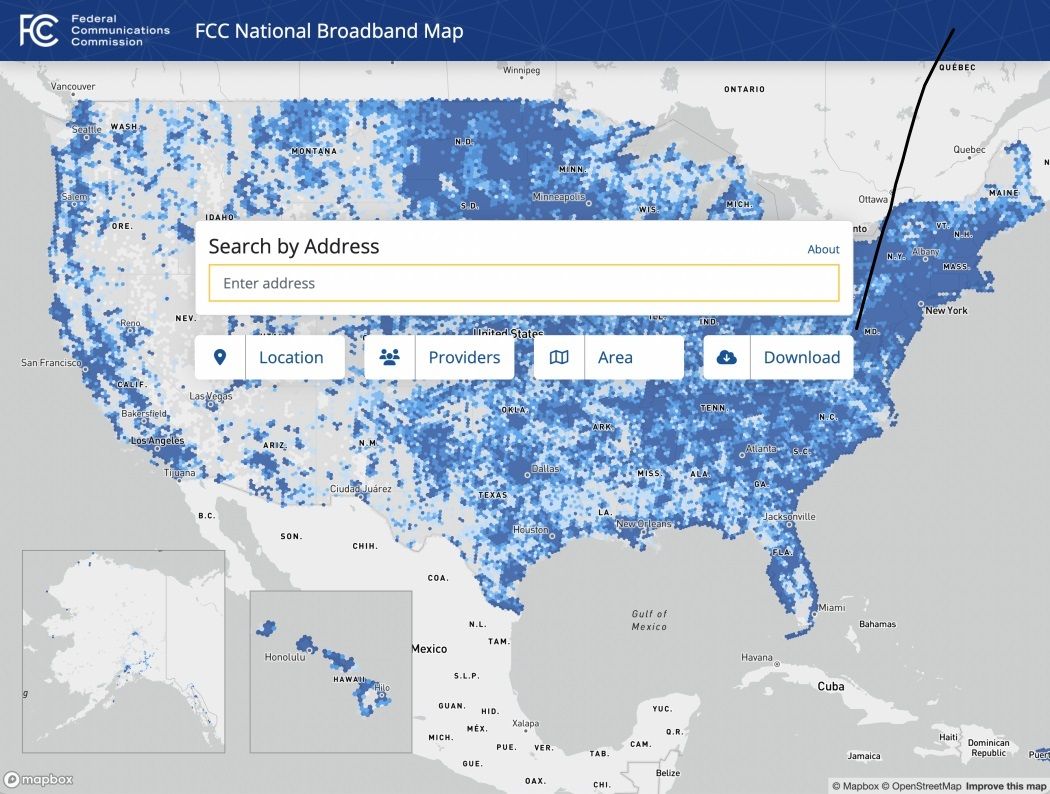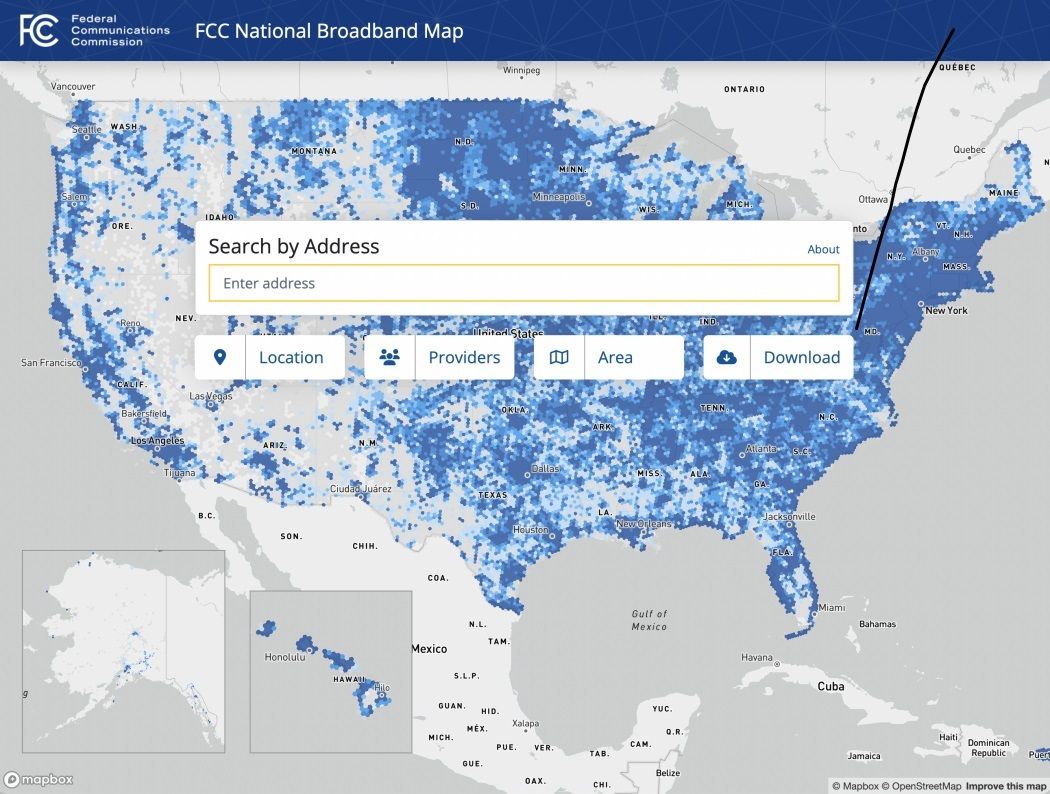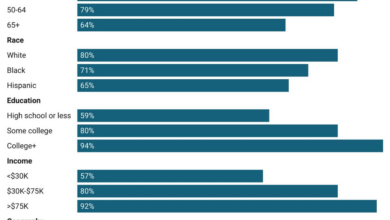FCC Broadband TV A New Era
FCC broadband television on the way is set to revolutionize how we watch TV. This exciting development promises a future filled with new possibilities for consumers, content providers, and the entire television industry. The FCC’s initiatives are poised to reshape the landscape of television broadcasting, potentially leading to a shift from traditional methods to a more flexible and accessible system.
This blog post explores the multifaceted aspects of this transition, examining the technical, regulatory, and consumer implications of this transformative shift. We’ll delve into the history of FCC involvement in broadband development, the technical underpinnings of broadband television, and the potential impact on existing services.
Introduction to FCC Broadband Television Initiatives
The Federal Communications Commission (FCC) has played a pivotal role in shaping the development of broadband communication in the United States. From its early involvement in regulating traditional television broadcasting to its current focus on high-speed internet access, the FCC’s influence has profoundly impacted the nation’s technological landscape. This evolution has been crucial in fostering innovation and accessibility in the media and entertainment industries.The FCC’s role extends beyond simply regulating; it actively fosters competition, innovation, and consumer choice in the communications sector.
This ongoing role is especially significant in the context of television, where the convergence of traditional broadcasting with broadband technologies is fundamentally altering the way audiences consume content.
Historical Overview of FCC’s Role in Broadband Development
The FCC’s involvement in broadband development can be traced back to its early regulations on radio and television broadcasting. These initial regulations laid the groundwork for the allocation of spectrum and the establishment of standards for broadcasting. Over time, the FCC’s regulatory framework adapted to accommodate the emergence of new technologies, including cable television and satellite communication. This adaptability has been key to maintaining a dynamic and responsive regulatory environment.
Evolution of Television Broadcasting Regulations in the Context of Broadband
The introduction of broadband technologies has significantly altered the landscape of television broadcasting. Initially, television signals were broadcast over airwaves. With the advent of cable television, a new distribution method emerged, allowing for the delivery of more channels and higher-quality signals. Now, with broadband internet, television content can be delivered through streaming services, potentially disrupting the traditional broadcast model.
This transition has necessitated a reassessment of the FCC’s regulatory approach to television, focusing on ensuring fair competition and consumer choice in the evolving media landscape.
Current FCC Initiatives Related to Broadband and Television
The FCC’s current initiatives encompass a range of strategies aimed at fostering broadband adoption and addressing the changing dynamics of television distribution. These initiatives may include promoting the development of infrastructure, ensuring equitable access to broadband services, and encouraging innovation in television technologies. This proactive approach seeks to facilitate the integration of television content delivery with broadband infrastructure, ultimately enhancing consumer access and choice.
Potential Impact of These Initiatives on the Television Industry
The FCC’s initiatives are poised to have a substantial impact on the television industry. These initiatives may encourage innovation in content creation and distribution, foster competition among different television providers, and lead to a more diverse range of television content options for consumers. The impact is multifaceted, affecting not just broadcasters but also streaming services, cable companies, and other stakeholders in the television ecosystem.
Comparison of Past, Present, and Future Broadband Policies
| Aspect | Past Policies | Present Policies | Future Policies (Potential) |
|---|---|---|---|
| Spectrum Allocation | Primarily focused on broadcasting, with limited consideration for broadband use. | Recognizes the importance of spectrum for broadband, allocating portions specifically for this purpose. | Potential for dynamic spectrum allocation based on demand and technological advancements. This might involve auctions or other mechanisms to optimize spectrum use. |
| Broadband Infrastructure | Limited focus on broadband infrastructure development, primarily focusing on broadcasting. | Increasing emphasis on expanding broadband access across the country. | Potentially include policies that incentivize the development of advanced fiber-optic networks and other high-capacity infrastructure. |
| Regulation of Streaming Services | Minimal regulation of streaming services; largely unregulated. | Regulations evolving to address issues like content ownership, copyright, and consumer protection in the context of streaming services. | Possible development of regulations to address issues like data privacy, content filtering, and the potential for monopolization in the streaming market. |
| Television Broadcasting | Regulations focused on traditional broadcasting methods. | Regulations adapting to accommodate the convergence of television and broadband technologies. | Potential regulations to support the continued development of television content delivery via broadband, and address the changing consumption habits of audiences. |
Understanding the “Broadband Television” Concept
The FCC’s push for broadband television signals represents a significant shift in how we consume and distribute video content. This new paradigm leverages the existing broadband infrastructure to deliver television programming, potentially disrupting the traditional cable television model. It promises a more flexible and potentially more affordable way to access television, but also introduces new challenges and considerations.Broadband television, in the context of FCC initiatives, signifies the delivery of television programming over high-speed internet connections.
This contrasts with traditional methods that rely on dedicated cable or satellite signals. The key is to leverage the existing infrastructure and rapidly evolving broadband technologies to provide television content, and to determine how best to implement it in a way that is accessible and equitable.
Definition of Broadband Television, Fcc broadband television on the way
Broadband television is the delivery of television programming via broadband internet connections, potentially replacing or complementing traditional cable or satellite TV. This approach utilizes existing broadband infrastructure to transmit video signals, often using advanced compression techniques. This allows for the delivery of high-quality video content without the need for dedicated physical lines.
Technical Aspects of Delivery
Delivering television content over broadband networks involves several technical considerations. Video compression techniques, such as MPEG-4 or H.264, are crucial to reduce the bandwidth requirements for high-quality video transmission. Streaming protocols, like HTTP Live Streaming (HLS) and MPEG-DASH, are employed to ensure efficient and reliable delivery. Furthermore, robust buffering mechanisms are essential to maintain a smooth viewing experience, particularly in environments with fluctuating internet speeds.
Buffering helps to manage occasional interruptions or variations in connection quality.
Comparison of Broadband Technologies
Several broadband technologies can support television delivery. Fiber optic networks, with their extremely high bandwidth capacity, are ideal for delivering high-definition (HD) and ultra-high-definition (UHD) video. Cable internet, while prevalent in many areas, has limitations in terms of bandwidth capacity compared to fiber. DSL, while accessible in many locations, typically offers lower bandwidth than cable or fiber, potentially impacting the quality and experience of viewing.
Wireless technologies, such as 5G and Wi-Fi 6, are becoming increasingly capable of handling television streaming, but consistent high-quality delivery remains a challenge in some areas.
Potential Challenges
Implementing broadband television services presents several challenges. One major concern is ensuring consistent high-quality service to all users, particularly in areas with less robust broadband infrastructure. Maintaining content availability and access across diverse devices and platforms is another critical aspect. Furthermore, addressing the cost of content acquisition, delivery, and device compatibility is essential for widespread adoption. Potential interoperability issues between different devices and platforms also need consideration.
Television Delivery Methods and Their Pros and Cons
| Delivery Method | Pros | Cons |
|---|---|---|
| Fiber Optic | High bandwidth, low latency, high-quality video | High installation costs, limited availability in some areas |
| Cable Internet | Wide availability, relatively low cost | Variable bandwidth, potential latency issues, may not be sufficient for UHD |
| DSL | Wide availability, lower cost | Lower bandwidth, potential latency issues, less suitable for high-definition video |
| 5G/Wi-Fi 6 | Increasing capacity, potential for mobile viewing | Signal quality can vary, reliability depends on coverage |
Implications for Consumers
Broadband television, a convergence of internet-based streaming and traditional television, promises a revolutionary shift in how we consume entertainment. The potential benefits are substantial, offering consumers a personalized, on-demand experience unlike anything previously available. However, the transition will also bring new challenges and considerations. This section explores the potential benefits, the impact on consumer habits, and the potential challenges consumers might face.
Potential Benefits for Consumers
Broadband television offers a compelling array of benefits, significantly enhancing the television viewing experience. Consumers will have access to a vast library of content, from classic movies to the latest shows, all readily available at their fingertips. The ability to pause, rewind, and skip through content allows for a truly personalized viewing experience, eliminating the constraints of traditional broadcast schedules.
- Enhanced Content Variety: Consumers can access a far broader range of content than traditional television, encompassing a wide spectrum of genres, languages, and perspectives. This includes niche interests and international programming that may not be readily available through traditional broadcast methods. This diversity empowers consumers to curate their viewing experiences based on their specific interests, avoiding the often broad and generic content offerings of traditional television.
- On-Demand Availability: Consumers gain the freedom to watch content whenever and wherever they choose, eliminating the need to adhere to rigid broadcast schedules. This flexibility empowers consumers to tailor their viewing habits to their own timetables and preferences.
- Personalized Recommendations: Smart algorithms can analyze viewing habits to provide tailored recommendations, ensuring that consumers are exposed to content they are most likely to enjoy. This personalization can foster a more engaging and rewarding viewing experience.
Impact on Consumer Choices and Television Consumption Habits
The introduction of broadband television will undoubtedly alter consumer choices and television consumption habits. Consumers will increasingly opt for streaming services over traditional cable, driven by the flexibility and cost-effectiveness of broadband television. This shift could lead to a decline in traditional cable subscriptions and an increase in subscriptions to various streaming platforms.
- Increased Choice: Consumers will face a wider selection of content options, enabling them to choose from a greater range of shows, movies, and other entertainment. The ease of accessing a vast library of content will influence consumer choices in entertainment consumption.
- Shifting Viewing Patterns: Consumers may spend less time passively watching television and more time actively engaging with the content, through features such as interactive elements and social sharing options. This shift in viewing habits could impact how consumers interact with their entertainment.
Examples of New Services and Features
Broadband television will bring a plethora of innovative services and features. These include interactive elements within the content, personalized recommendations, and enhanced social features.
- Interactive Elements: Content creators can introduce interactive elements, such as polls, quizzes, or Q&A sessions, allowing viewers to participate in the viewing experience in real-time. This will increase viewer engagement and provide a dynamic viewing experience.
- Personalized Recommendations: Streaming services will use sophisticated algorithms to analyze viewing patterns and offer tailored recommendations, helping consumers discover new content they might enjoy. This will allow consumers to experience a curated viewing experience.
- Enhanced Social Features: Broadband television platforms can integrate social features, enabling viewers to share their opinions and experiences with friends and family in real-time. This fosters a more interactive and engaging environment for viewers.
Potential Pricing Models
Various pricing models for broadband television services are conceivable, impacting consumer affordability and value. These models could range from tiered subscription plans to a la carte options.
So, FCC broadband television is finally on the way! It’s exciting to see this progress, but sometimes, even with advancements, there are interesting parallels to be drawn. For instance, while considering the potential benefits of this new technology, it’s worth exploring the often-overlooked positive aspects of computer viruses – like, say, how they can sometimes reveal vulnerabilities in a system, much like the FCC’s new initiative will expose the gaps in our current television infrastructure.
Ultimately, though, we’re all still hoping for a smooth and accessible broadband television experience. whats good about computer viruses is a fascinating read for anyone interested in this type of deeper perspective.
- Tiered Subscription Plans: Providers might offer different subscription tiers, each with varying content access and features, catering to different consumer budgets and preferences. These tiered options offer diverse choices for customers based on their needs and financial constraints.
- A la Carte Options: Consumers could choose to pay only for the specific content they want to access, rather than subscribing to a comprehensive package. This allows consumers to curate their entertainment packages, paying only for what they want.
Potential Consumer Benefits and Drawbacks
| Consumer Benefit | Consumer Drawback |
|---|---|
| Enhanced content variety and personalized recommendations | Potential for information overload and difficulty in navigating a vast amount of content |
| On-demand access and flexibility | Potential for increased screen time and sedentary behavior |
| Interactive features and social sharing | Privacy concerns related to data collection and use |
| Cost-effective options | Potential for hidden costs or unexpected fees |
Implications for Content Providers

The FCC’s broadband television initiatives represent a significant shift in the media landscape, potentially reshaping the business models and strategies of content providers. Understanding the implications of this transition is crucial for navigating the changing environment and capitalizing on the opportunities that arise. This new era of broadband television will demand adaptability and innovation from all players in the ecosystem.The arrival of broadband television opens up a world of possibilities for content providers, but it also introduces new challenges.
Content providers must be prepared to adapt their strategies to meet the demands of a dynamic market, and this adaptation will require a comprehensive understanding of the new technological capabilities and consumer preferences. It’s no longer enough to simply deliver content; providers must now deliver it in a way that is optimized for broadband access, and in a manner that is attractive to the consumers.
Potential Impact on Streaming Services
Streaming services will face a complex interplay of opportunity and challenge. The potential for increased viewership and revenue is significant, but the need to adapt to new distribution models and competitive pressures is equally crucial. Services that can effectively leverage the broadband environment to offer higher quality video, interactive features, and personalized content experiences will likely gain a competitive advantage.
Furthermore, they need to be prepared to potentially face competition from new entrants who are better positioned to utilize the new technologies and capabilities.
Potential Impact on Television Networks
Television networks, traditionally reliant on linear broadcasting, will need to strategically adapt to the evolving landscape. Opportunities exist to develop new, interactive content and services tailored for broadband delivery. This may involve creating more personalized and on-demand viewing experiences, offering exclusive content that is only accessible through the broadband network, and/or developing partnerships with streaming services to expand their reach.
The ability to create and deliver targeted content to specific demographics will be crucial. However, maintaining existing subscriber bases and transitioning to a new model will be a major challenge.
So, FCC broadband television is apparently on the way, which is exciting news for internet access. However, it’s a little concerning to see how spyware targeted at congressional hearing ( spyware targeted at congressional hearing ) is impacting the digital landscape. Hopefully, this won’t slow down the FCC’s progress on getting broadband television to everyone. It’s a tricky balancing act, but I’m optimistic about the future of internet access for all.
Opportunities for Content Providers
Content providers can leverage the advantages of broadband television to create innovative services. This includes developing interactive content, personalized recommendations, and virtual reality (VR) experiences. The creation of live streaming events with enhanced interactive features, and the incorporation of social media integration into the viewing experience, will likely become increasingly important. By focusing on high-quality production, personalized content recommendations, and innovative user interfaces, content providers can position themselves for success in this new era.
Challenges for Content Providers
Content providers face several challenges in this new environment. One major challenge is the need to invest in new technologies and infrastructure to deliver high-quality content to consumers. Another significant challenge is managing the complexities of a multi-platform distribution strategy, ensuring a seamless viewing experience across various devices. Moreover, the competitive landscape will intensify, with new entrants and established players vying for consumer attention.
Innovation Examples
Content providers could innovate by developing interactive shows that incorporate audience participation. Creating immersive virtual reality experiences within the streaming platform is another possible avenue. Personalized content recommendations based on individual viewing habits, or the creation of live streaming events with enhanced interactive features, are further examples of innovation. A significant opportunity lies in creating exclusive content tailored to broadband delivery, perhaps using advanced algorithms to suggest content.
Comparison of Business Models
| Business Model | Description | Strengths | Weaknesses |
|---|---|---|---|
| Linear Broadcasting | Traditional television broadcasting | Established infrastructure | Limited interactivity, less personalized content |
| Streaming Services | Content delivered over the internet | Personalized recommendations, interactivity | Requires substantial infrastructure, competition from new entrants |
| Hybrid Models | Combining linear and streaming services | Leveraging existing infrastructure, expanded reach | Complexity in management, potential for overlapping services |
Infrastructure and Technological Aspects

Broadband television, a revolutionary concept, hinges on a robust infrastructure and cutting-edge technology. This section delves into the crucial components required to support this new medium, examining the role of ISPs, necessary technological advancements, and critical security considerations. The evolution of this technology will shape the future of entertainment and communication.
Required Infrastructure
The infrastructure for broadband television necessitates significant investment in fiber optic networks and high-capacity transmission lines. Existing cable infrastructure can be adapted, but upgrades are often required to handle the higher bandwidth demands. This involves significant upgrades to existing infrastructure and potentially new construction in underserved areas. Furthermore, robust backhaul systems are needed to connect remote locations and ensure consistent service.
Role of Internet Service Providers (ISPs)
ISPs play a pivotal role in delivering broadband television services. Their existing infrastructure, including fiber optic networks and cable systems, forms the foundation for broadband television distribution. ISPs must invest in upgrading their networks to support higher bandwidth requirements and potentially develop new distribution models. They will also need to collaborate with content providers to ensure seamless delivery and optimal user experience.
Technological Advancements
Several technological advancements are crucial for the success of broadband television. These include:
- Advanced compression techniques: These methods are needed to compress video and audio data to enable efficient transmission over broadband networks. For example, high-efficiency video coding (HEVC) and other next-generation codecs are essential for maintaining quality while minimizing bandwidth usage.
- Smart TVs and streaming devices: These devices must be capable of receiving and displaying high-quality broadband television content. This includes compatibility with various video formats and protocols.
- Improved network protocols: Efficient protocols are required to manage the vast amount of data involved in delivering high-definition video. These protocols need to ensure minimal latency and high reliability.
Security Considerations
Security is paramount for broadband television services. Protecting user data, preventing unauthorized access to content, and ensuring the integrity of transmitted signals are critical concerns. Robust encryption methods and multi-layered security protocols are essential to safeguard sensitive information and prevent breaches.
The FCC’s broadband television initiative is definitely on the horizon, promising some exciting changes. This is a significant step, and it’s clear that it’s part of a larger evolution in the industry. Looking at the bigger picture, we can see how this fits into the broader trends of technological advancement, and how it will impact the future.
For instance, the way we think about the shapes of things to come the shapes of things to come will be completely reshaped by this. Ultimately, the FCC’s broadband TV plan is a fascinating development that will dramatically alter how we experience entertainment.
Technological Components of Broadband Television
| Component | Description |
|---|---|
| Fiber Optic Networks | High-capacity transmission lines capable of carrying large amounts of data, essential for delivering high-definition video content. |
| High-Efficiency Video Coding (HEVC) | Advanced compression technique for video, enabling efficient transmission over broadband networks, maintaining quality while minimizing bandwidth usage. |
| Smart TVs and Streaming Devices | Devices capable of receiving and displaying high-quality broadband television content, supporting various video formats and protocols. |
| Network Protocols | Efficient protocols to manage the large volume of data, ensuring minimal latency and high reliability in delivering high-definition video. |
| Security Protocols | Robust encryption methods and multi-layered security protocols to safeguard sensitive information and prevent unauthorized access or breaches. |
Regulatory Landscape and Policies
The FCC’s role in shaping the future of broadband television is crucial. Understanding the regulatory framework surrounding this emerging technology is vital for consumers, content providers, and infrastructure developers alike. This section explores the FCC’s existing policies, potential legal implications, and historical examples to illuminate the path forward.The FCC’s regulatory approach to broadband television will likely impact the entire ecosystem, from content creation to viewer access.
Successful implementation hinges on a nuanced understanding of the technical and legal aspects. Navigating this complex landscape requires foresight and a clear understanding of potential pitfalls.
FCC’s Regulatory Framework
The Federal Communications Commission (FCC) holds significant regulatory authority over broadcasting and communications in the United States. This authority extends to the allocation of spectrum, licensing of broadcasters, and establishment of technical standards. While the FCC has not yet formally defined a specific regulatory framework for broadband television, its existing regulations regarding broadcast television and internet services provide a foundation for future policies.
These regulations, which include those governing spectrum usage and net neutrality, will need to be adapted or extended to accommodate the unique characteristics of broadband television.
Potential Legal and Policy Implications
The introduction of broadband television presents significant legal and policy challenges. One key concern is ensuring equitable access to this new technology, addressing potential digital divides. Protecting intellectual property rights of content creators in a new media environment is another critical issue. Further, regulations regarding copyright, licensing, and potential conflicts of interest in content production and distribution need to be addressed.
The impact on existing media ownership rules and spectrum allocation needs careful consideration.
Successful and Unsuccessful Regulatory Approaches
The history of media regulation offers both successful and unsuccessful examples. The transition from analog to digital television provides a case study in successful regulatory adaptation. Clear guidelines and phased implementation minimized disruptions. Conversely, the challenges faced during the transition to the internet highlight the difficulties of anticipating technological changes and the need for flexible regulations. The initial regulatory approach to the internet, while aiming to control certain aspects, proved insufficient to accommodate the rapid evolution of the technology.
Learning from past successes and failures will be crucial for establishing effective broadband television regulations.
Regulatory Challenges and Hurdles
Implementing broadband television policies faces several challenges. The rapid pace of technological advancement necessitates flexible regulations to accommodate future innovations. Balancing the needs of content providers, consumers, and infrastructure developers requires careful consideration. Furthermore, ensuring international compatibility and coordination of regulations across different regions presents a significant hurdle. The need for international cooperation is particularly critical given the global nature of content creation and distribution.
Comparative Regulatory Environments
| Country/Region | Broadband Television Regulations | Key Features | Challenges |
|---|---|---|---|
| United States | In development | Focus on existing spectrum and internet regulations. Potential for a phased approach. | Balancing innovation with existing stakeholders’ concerns. |
| European Union | Varying, dependent on member states | Emphasis on consumer protection and harmonization. | Ensuring a single market approach while respecting national interests. |
| China | State-controlled | Focus on national interests and digital infrastructure development. | Potential lack of transparency and consumer choice. |
| South Korea | Progressive, supportive of new technologies | Prioritizing innovation and development. | Potential for unintended consequences and overregulation. |
This table offers a preliminary comparison of regulatory environments. Each region’s approach reflects its unique economic, social, and technological context. Further research and analysis are needed to provide a comprehensive understanding.
Potential Impacts on Existing Television Services: Fcc Broadband Television On The Way
The advent of broadband television promises a seismic shift in the television landscape, potentially reshaping the way consumers access and experience television content. This shift will impact existing services like cable, satellite, and over-the-air television, forcing adaptation or risk obsolescence. The introduction of this new technology introduces a new level of competition, and the potential for market disruption is substantial.The transition to broadband television will challenge traditional business models and necessitate innovation in the delivery and consumption of television programming.
Consumers, accustomed to specific platforms and services, will face a more complex and potentially more competitive media landscape. Existing providers will need to strategize effectively to maintain relevance and customer loyalty in the face of this new technology.
Impact on Cable TV
Cable television, traditionally the dominant force in the television market, faces significant challenges. Its reliance on physical infrastructure and proprietary content agreements will need to be re-evaluated. The ability of cable companies to compete with broadband-delivered television will depend on their ability to offer bundled packages that include both broadband and television services, or potentially develop innovative streaming services of their own.
Furthermore, cable companies might need to acquire or merge with streaming services to stay competitive. Examples of companies adjusting to the digital age include Comcast’s investment in streaming services and the development of their own platforms to compete with streaming giants.
Impact on Satellite TV
Satellite television, with its widespread reach, faces a unique set of challenges. The ability of satellite television to deliver high-quality, broadband-like services will determine its future. The significant investment in satellite infrastructure may not be easily transferable to the new technology. Adaptation will require either a significant investment in upgrading existing infrastructure or a shift to a new model that incorporates broadband technology.
The potential for satellite television to transition into a niche market, focused on areas with limited broadband access, is also possible.
Impact on Over-the-Air Television
Over-the-air television, relying on broadcast signals, faces the most immediate and significant threat. The declining viewership of traditional broadcast networks, coupled with the rising popularity of broadband services, poses a considerable challenge. The ability of over-the-air television to offer high-quality programming at a low cost is important. Over-the-air television providers may need to partner with broadband providers or develop their own streaming services to remain competitive.
Potential scenarios could include a transition to digital-only broadcasting or becoming a supplementary service within the larger broadband ecosystem.
Potential for Competition and Market Disruption
The introduction of broadband television will introduce intense competition among existing television providers and new entrants. Existing providers will need to adapt quickly to survive, while new companies will leverage the new technology to gain market share. The potential for market disruption is substantial, as existing business models are challenged.
Potential for Mergers and Acquisitions
The television industry is likely to experience a wave of mergers and acquisitions. Companies will seek to consolidate their market position, gain access to new technologies, and create more comprehensive entertainment offerings. This could lead to the creation of larger, more powerful media conglomerates that control a significant portion of the television market.
Competitive Landscape Before and After Broadband Television
| Aspect | Before Broadband Television | After Broadband Television |
|---|---|---|
| Delivery Method | Cable, Satellite, Over-the-Air | Broadband, Cable (potentially enhanced), Satellite (potentially adapted), Over-the-Air (potentially supplementary) |
| Content Availability | Limited by infrastructure and licensing agreements | Potentially vast library of content, depending on the model and provider |
| Pricing | Fixed fees for bundled services | Potentially more diverse pricing models, subscriptions, and pay-per-view options |
| Competition | Established players with market dominance | More dynamic and diverse landscape with new players and disruptive models |
Last Recap
In conclusion, the FCC’s push toward broadband television presents both thrilling opportunities and significant challenges. Consumers stand to gain access to a wider range of content and more flexible viewing options, but navigating potential price fluctuations and the transition away from familiar services will be crucial. Content providers will need to adapt to new distribution models, potentially facing competition and disruption.
The regulatory landscape will need to adapt to these new technologies, balancing innovation with consumer protection and fair competition. The future of television is truly on the horizon, and the coming years will be pivotal in shaping the final form.







